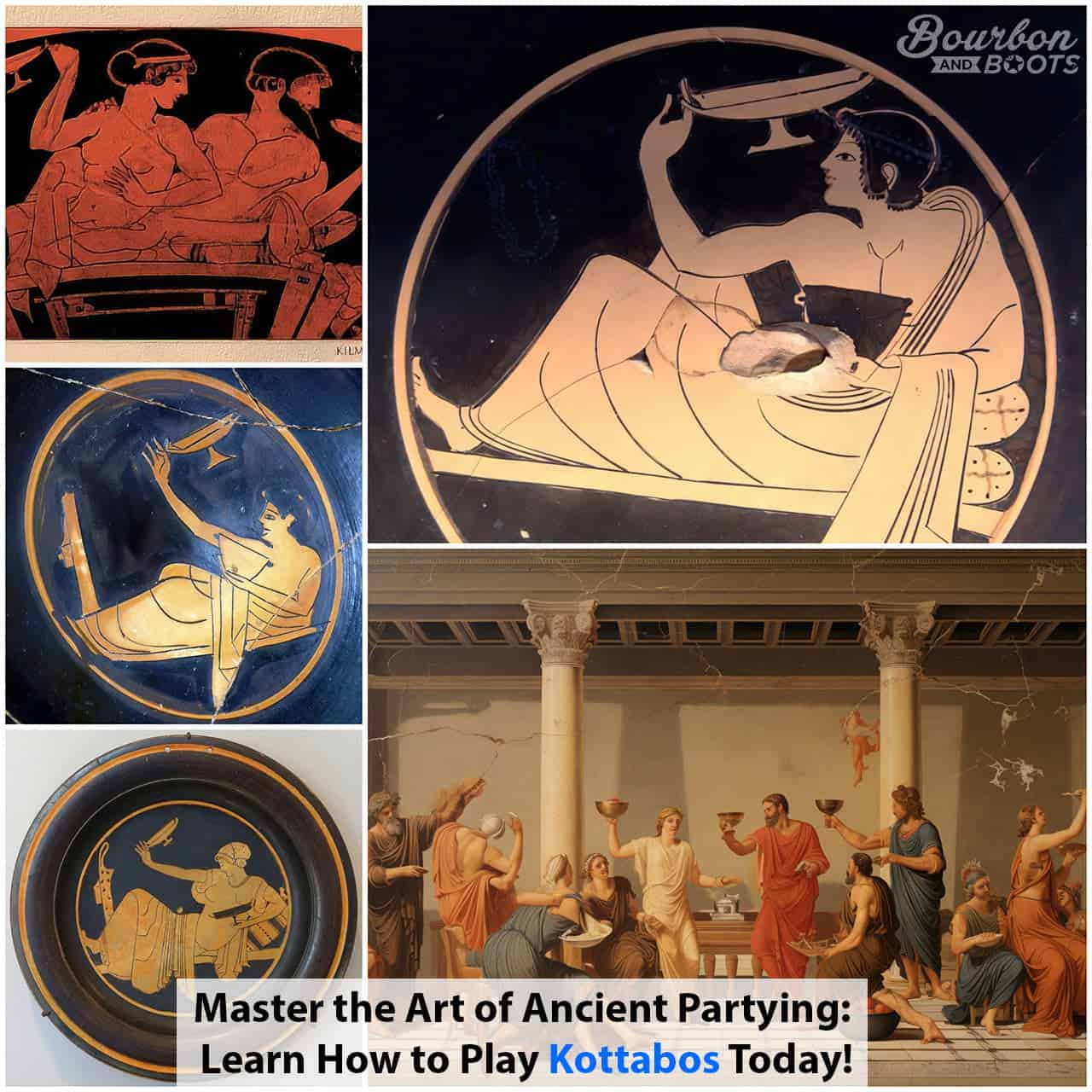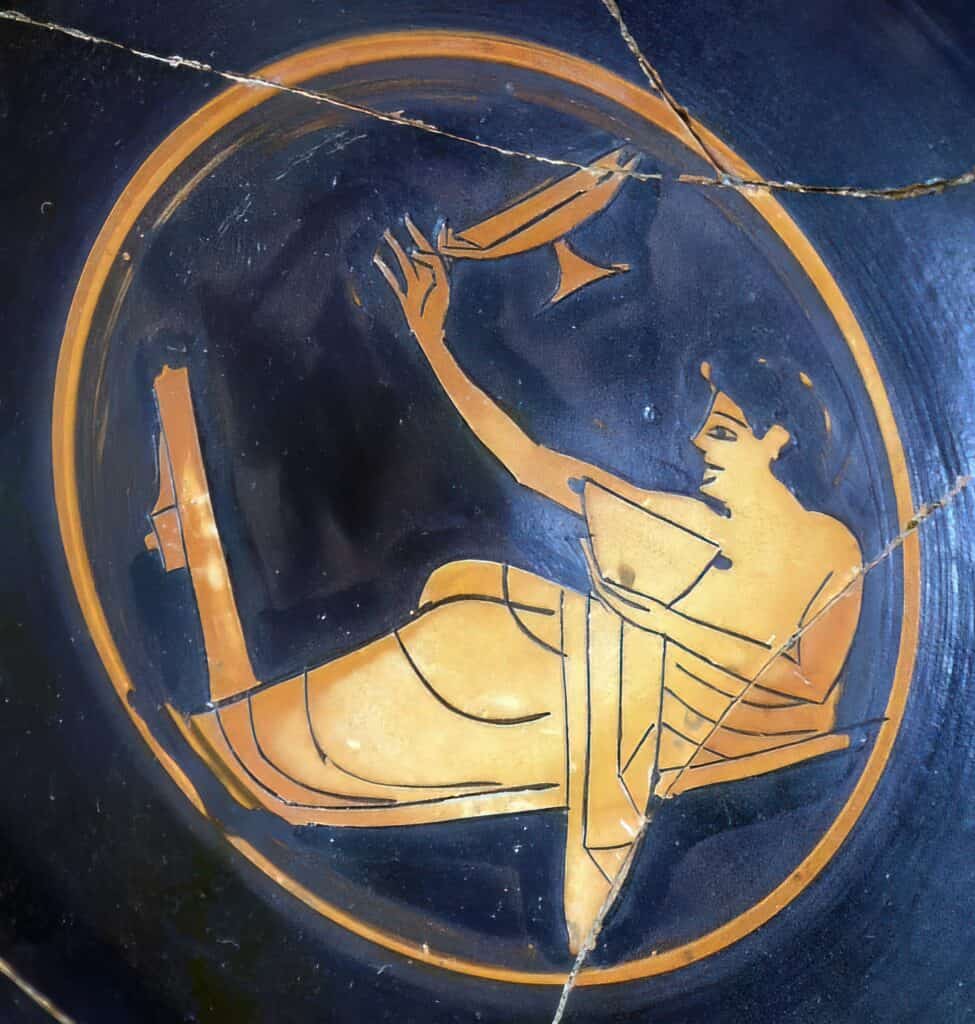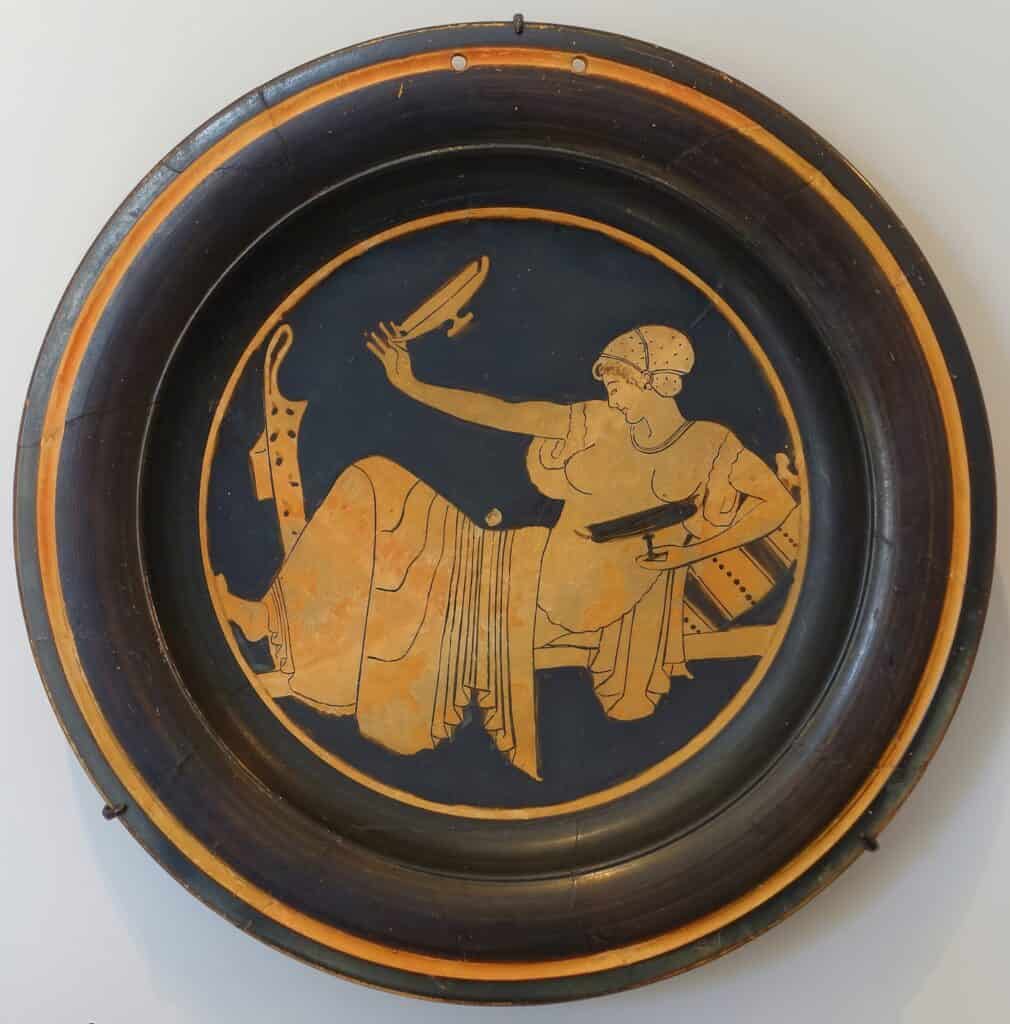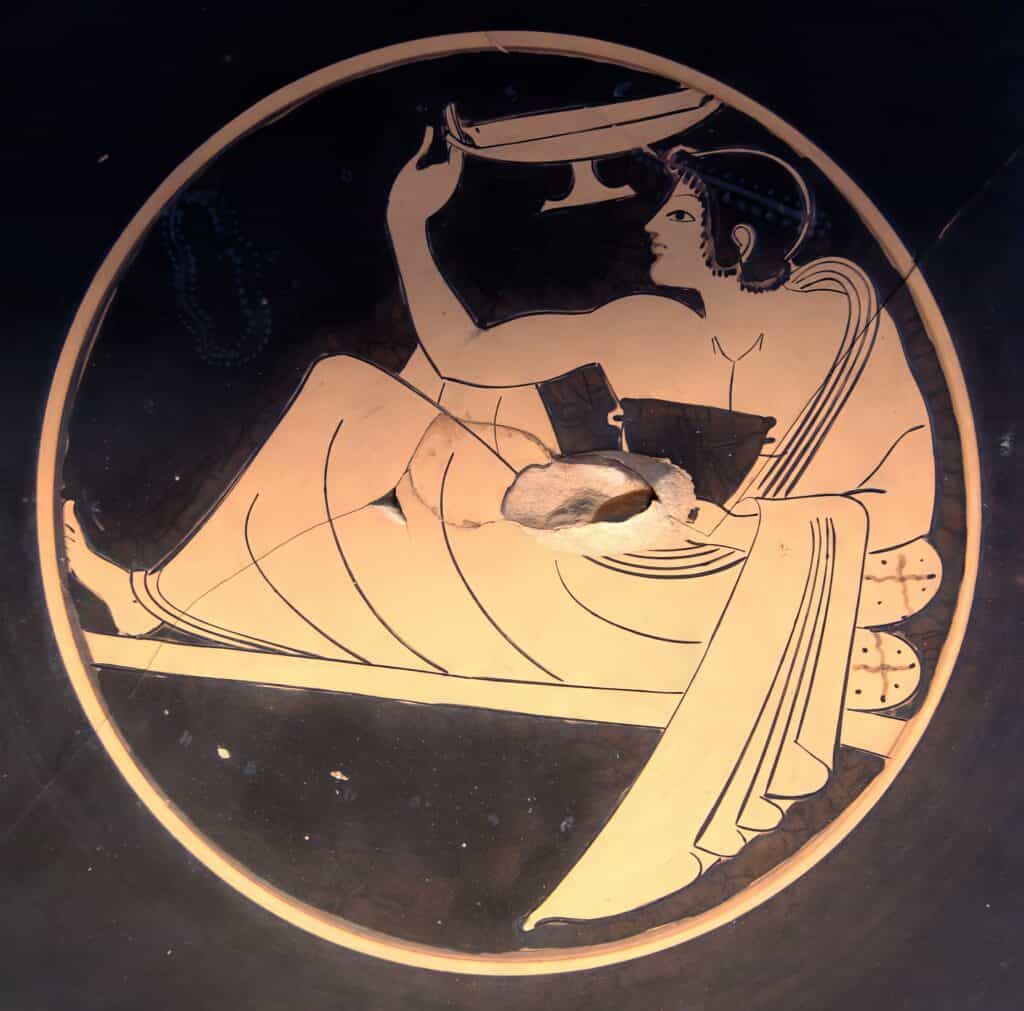Have you ever wanted to step back in time and experience the thrill of an Ancient Greek drinking game? Welcome to Kottabos, a popular pastime at symposia over 2000 years ago! This guide will unlock the secrets of this unique wine-slinging challenge, offering step-by-step instructions on how to play, along with fascinating historical insights.
Ready for a journey into ancient revelry unlike any other? Let’s dive in.
Key Takeaways
Kottabos is an ancient Greek drinking game that was popular at symposia over 2000 years ago. It involved flicking wine-lees at a target in the middle of the room using a strategic flicking technique.
The game had various variations, including Kottabos kataktos and Kottabos with oxybapha, which added unique twists to the gameplay, such as knocking down a small disc or slinging wine-filled cups at a target.
Women played an important role in Kottabos, challenging traditional gender norms of the time. They actively participated as players and dedicated their throws to male lovers or potential suitors.
Despite being obsolete today, there has been a resurgence of interest in reviving the ancient Greek drinking game. Modern references can be found in literature, art, and popular culture.
Table of Contents
The Historical Origins of Kottabos

Kottabos, a game of unique skill and strategy, made its mark in the symposia of Ancient Greece and Etruscan societies around the 6th and 5th centuries BC. Originally beloved for its fun factor at wine-soaked social gatherings, Kottabos quickly evolved into a competitive sport that required dexterity akin to javelin throwing.
With Dionysius Chalcus, Alcaeus, Anacreon, and Pindar, among others like Bacchylides, Aeschylus, and Sophocles, all make references to this intriguing pastime in their works.
Depicted on red-figure vases found across Sicily, Italy, and Greece, artifacts reveal how players would partake in strategic flicking of wine-lees at specific targets set up within an assembly room.
Not just about aim accuracy or power but moreover with successful execution symbolic of one’s future accomplishments, particularly concerning matters of love. Kottabos thus held high stakes both as gambling entertainment at symposia and crucial display of social status indicators within ancient Greek culture.
Rules and Gameplay of the Kottabos Drinking Game
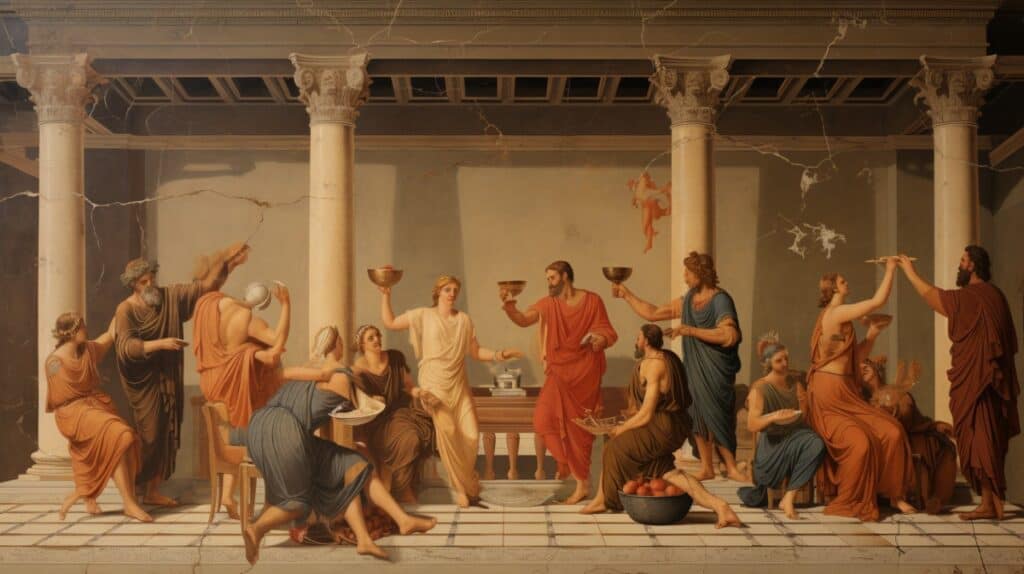
The Kottabos drinking game, popular in Ancient Greece and Etruscan symposia, involved flinging wine-lees at a target in the middle of the room.
Basic rules
Kottabos, the ancient Greek drinking game, has a set of intriguing rules that make it both fun and challenging.
- Players sit around a circular table, each with their own kylix or deep drinking cup filled with wine.
- A small bronze statue (known as the “Manes”) or other form of target is placed in the middle of the table.
- The aim is to throw wine – lees, the sediment at the bottom of your cup, towards this target.
- Using a strategic flicking technique, you should attempt to fling these wine dregs by tilting your cup and releasing them in a swift motion.
- Points are earned based on how close you get to hitting or knocking over the target; precision and dexterity are key to success.
- Prizes such as sweetmeats or kisses are awarded to those who excel in this artistic display of wine-slinging prowess.
Kottabos kataktos variation
In the fascinating world of ancient Greek drinking games, one particular variation of Kottabos, known as Kottabos kataktos, is worth delving into. Here’s what sets it apart:
- Participants in Kottabos kataktos need to demonstrate exceptional skill and precision.
- The primary target for Kataktos players is a small disc strategically balanced on top of a bronze lamp stand.
- This disc, often made from ceramic or metal, requires a deft touch to dislodge.
- Strategically flicking wine – lees becomes crucial as the objective revolves around knocking off this delicate disk without disrupting the stand itself.
- This form of the game originated in coastal Sicily before captivating enthusiasts across Greece and beyond.
- The combination of an intimate setting with high stakes – namely your personal servant – made Kottabos kataktos a compelling part of symposia events.
- Playing Kataktos was interpreted as an indication of future success, particularly in romantic endeavors, which added an extra layer of competition among players.
- This variant was common in Athens, where Dionysius Chalcus reminisced about his experiences playing Kottabos kataktos with Alcaeus and Anacreon.
Kottabos with oxybapha variation
Kottabos with oxybapha is a variation of the ancient Greek drinking game that added an exciting twist to the gameplay. Here are some key details about this unique version:
- Oxybapha: In this variation, instead of flicking wine dregs at a plastinx or small bowls, players would sling or throw wine-saturated lekane cups into a rhabdus target.
- Lekane Cups: The lekane cups used in Kottabos with oxybapha were shallow and wide, making them perfect for holding and slinging wine.
- Rhabdus Target: The rhabdus was a tall pole or rod attached to a base, and players would aim their throws to knock it down.
- Strategic Flicking: Similar to the original game, players needed accuracy and technique when throwing the lekane cups to hit the rhabdus target.
- Wine-slinging Fun: The addition of slinging wine-filled cups added an extra element of excitement and skill to Kottabos gameplay.
- Higher Difficulty Level: Kottabos with oxybapha required more precision than the basic version since players had to account for the increased weight and movement of the lekane cups.
- Competitive Gameplay: Like all variations of Kottabos, this version was also played competitively, with players aiming for higher scores or trying to outperform their opponents.
- Success Rewards: Winners of Kottabos with oxybapha could receive rewards such as prizes or favors from courtesans, adding another layer of incentive to master this challenging variation.
- Erotic Dedication: Just like in other forms of Kottabos, players could dedicate their throws to a lover in an amorous pursuit during the game, adding an erotic element.
- Historical Disappearance: Despite its unique and challenging gameplay, Kottabos with oxybapha, like the other variations of the game, disappeared from popularity in ancient Greece around the 4th century BC.
Combination of kataktos and oxybapha
Combining the kataktos and oxybapha variations of Kottabos can add an extra level of excitement and challenge to the game. Here’s how it works:
- Set up the special stand with a pole and a bowl at the bottom, just like in the kataktos version.
- Instead of using wine – lees, fill small saucers with wine and place them on top of the pole.
- Players take turns using strategic flicking to try and knock over the saucers.
- The goal is to sink as many saucers as possible using the least amount of throws.
- As with the kataktos game, skill and precision are key, but now players have to adjust their technique for throwing at moving targets.
- The combination of kataktos and oxybapha adds an extra element of challenge and fun to the game.
Cultural Influence and Significance of Kottabos
Kottabos had a significant cultural influence in ancient Greece, with the game becoming an integral part of symposia and social gatherings. Women also played a role in Kottabos, challenging traditional gender norms of the time.
Today, there are references to Kottabos in popular culture, and modern revivals of the game can be found.
Kottabos toast tradition
During the ancient Greek symposia, the Kottabos drinking game was more than just a test of skill and aim. It also had its own unique toast tradition that added an extra layer of excitement to the game.
As players flicked wine-lees at their targets, they would simultaneously make a toast to honor someone or something important. These toasts often took on a romantic tone, with men dedicating their throws to their male lovers in acts of amorous pursuit.
The competitive nature of the game, combined with these heartfelt toasts, created a high-stakes atmosphere where fortunes could be won or lost with each successful throw.
Role of Women in Kottabos

Women played a significant role in the game of Kottabos, a popular ancient Greek drinking game. Despite being excluded from many aspects of society at the time, women were allowed to participate as players in this competitive and ritualistic game.
Depictions on vases show that women actively engaged in Kottabos, showcasing their dexterity and skill alongside men. They played the game as “hetairai,” which were courtesans or female companions at symposia.
The involvement of women in Kottabos highlighted their participation in social activities and love rituals, challenging societal expectations and emphasizing their importance in ancient Greek culture.
The game’s association with love and romance made it particularly appealing for women to play. Success in Kottabos was believed to represent success in relationships and being loved by young men and women alike.
Players would dedicate their throws to a male lover or potential suitor, adding an erotic element to the competition. Women’s participation not only reflected cultural significance but also shaped social dynamics between genders during symposia gatherings.
Modern references and revivals of Kottabos
In recent times, there has been a growing interest in reviving the ancient Greek drinking game of Kottabos. Although the game has become obsolete, it still holds a certain allure for those fascinated by ancient culture and historical drinking games.
Modern references to Kottabos can be found in various forms of media, including literature, art, and even popular television shows. Despite this resurgence of interest, actually playing Kottabos today is quite rare due to its difficulty and the cleanup involved.
Nonetheless, the game’s cultural significance continues to intrigue and captivate enthusiasts who appreciate its unique place in history.
The Intriguing Artifacts of Kottabos
Intriguing artifacts of Kottabos include the Kottabos cup, which can be found in Oxford, showcasing the ancient Greek drinking game’s cultural and historical significance.
The Kottabos cup in Oxford
The Kottabos cup in Oxford is a fascinating artifact that gives us insight into the ancient Greek drinking game. This unique cup was specifically designed for playing Kottabos, with a conical-shaped projection at the bottom.
Players would fling wine-lees (sediment) toward a target in the middle of the room using this cup. It required skill and dexterity to hit the target and win prizes like cakes, sweetmeats, or even kisses.
The cup serves as a testament to how highly regarded Kottabos was during the Ancient Greek symposia.
Comparing Kottabos with Modern Drinking Games

The game of kottabos, known for its skill and dexterity, has its own unique charm, quite distinct from modern drinking games. However, there are some striking similarities and differences that paint an intriguing picture of how convivial gatherings and games have evolved over centuries. Here is a comparative study between the traditional game of kottabos and contemporary drinking games.
| Kottabos | Modern Drinking Games | |
|---|---|---|
| Origin | Originated in Sicily and became a fashionable game in Athens during the 6th and 5th centuries BC. | Modern drinking games have various origins, most of them being western. |
| Object of the Game | Players had to fling wine-lees at a target in the middle of the room. The game required dexterity, akin to throwing a javelin. | Objectives vary from game to game, some requiring more coordination, such as beer pong, while others, like Kings, involve completing tasks. |
| Playing Space | The game was played in circular buildings, ideally arranged for rapid succession of players. | Modern games can be played in various settings, including pubs, clubs, and at home, with minimal space requirements. |
| Symbolic Meaning | Kottabos was seen as a forecast of the future, especially in matters of love. Successful play was taken as a sign of being loved. | Modern drinking games typically do not carry symbolic meanings, focusing more on the fun element and social bonding. |
| Stakes | The stake was often a servant. Prizes could also include cakes, sweetmeats, or kisses. | Stakes in modern games often involve drinking amounts or performing silly actions, but rarely have tangible prizes. |
| Role of Women | Women did participate but were not usually the recipients of the toast. Their participation might have been seen as humorous or unconventional. | Modern games are typically gender-neutral, with women participating equally and often competitively. |
This comparison gives us a fascinating glimpse into how the social dynamics of games have shifted over time.
Frequently Asked Questions About Kottabos
What materials do I need to play Kottabos?
To play Kottabos, you will need a kylix (a type of ancient Greek wine cup) or any other small cup with a stem, as well as some wine.
How do you play Kottabos?
To play Kottabos, the player holds the kylix by its base or stem and dips it into the wine, filling it up halfway. The objective is to fling the remaining wine in the kylix toward a target in order to knock it down. The target can be anything from small figurines to saucers placed on stands.
What are the rules of Kottabos?
The rules of Kottabos vary slightly depending on regional variations, but generally, each player takes turns flinging their wine towards the target while trying to hit it with accuracy and skill. Points are awarded based on hitting specific parts of the target or achieving certain goals set before playing.
Can I modify the rules of Kottabos?
Yes! One of the interesting aspects of Kottabos is that there were many variations and adaptations throughout history. You can modify rules according to your preferences and make them more challenging or suitable for different group sizes and settings.
Conclusion: The Enduring Allure of Kottabos
In conclusion, the ancient Greek drinking game of Kottabos continues to captivate us with its unique blend of skill and revelry. From its historical origins in Etruscan symposia to its cultural significance and influence in ancient Greece, Kottabos has left an indelible mark on our understanding of wine culture and social interactions.
As we explore the intriguing artifacts and compare them to modern drinking games, it becomes clear that Kottabos holds a timeless appeal that transcends time and continues to fascinate both scholars and party-goers alike.
So why not gather some friends, raise a toast, and experience the excitement for yourself? Let the flicking, slinging, and strategic throwing begin as you immerse yourself in this ancient tradition!

